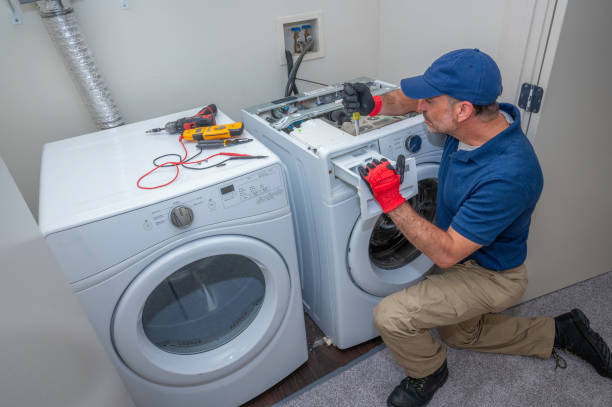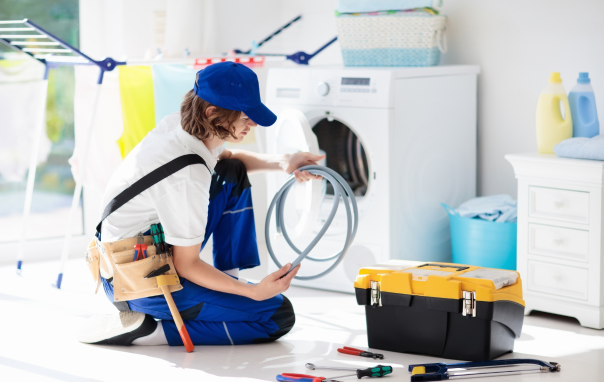Washing Machine Repair: How to Fix a Leaky Washing Machine

A leaking washing machine disrupts daily life, potentially causing water damage, stained floors, and a host of other hassles. For homeowners in Canada—especially around Toronto—knowing how to troubleshoot and fix a leaky washer can save considerable time and expenses. Toronto Refrigeration’s experienced technicians excel at diagnosing the source of water leaks, whether from a faulty drain hose, a worn tub seal, or a damaged water pump. This guide outlines common causes of washing machine leaks, key steps for repairs, and tips on preventative maintenance to keep your machine running smoothly and extend its lifespan.

Common Causes of Washing Machine Leaks
A washing machine leak is typically the outcome of a compromised component or a blocked water pathway. Understanding each possible source is crucial for quick, accurate repairs.
Leaks from the Drain Hose
The drain hose is responsible for moving dirty water out of the washer during wash cycles and drain cycle sequences. Loose hose connections, cracks over time, and a loose drain hose clamps can cause water to seep onto the floor. If the clamp or rubber washer is worn, water may drip consistently or only during specific times like mid-cycle.
Leaks from the Outer Tub
A washing machine’s outer drum or outer tub occasionally develops holes or cracks, particularly in older units subjected to heavy usage. A damaged tub can prompt water leakage throughout wash or spin cycles, indicating a deeper issue, like a failing tub seal that needs professional attention.
Leaks from Water Supply Hoses
Washers receive water from water inlet hoses connected to household plumbing. If these connections loosen or the hoses degrade, leaks often appear where the hoses attach to the machine or the home’s water valves. Using high-efficiency detergent or unbalanced loads can sometimes cause strain on these hoses, increasing the likelihood of problems.
Clogged Drain Hose Issues
Over time, detergent residue, foreign objects, or lint can build up inside the washing machine drain hose, impeding normal water flow. If water can’t drain properly, it may back up and overflow, causing messy spills on the laundry room floor. Clearing a clogged drain hose is often as easy as removing the blockage, but advanced clogs may require a drain snake or professional assistance.
Identifying Leak Sources
Diagnosing a washing machine leak can be tricky if you don’t know where to start. The quickest way is to run a cycle and monitor water seepage.
Signs of a Leak during the Wash Cycle
Leaks early on—particularly during the initial fill or wash cycles—often indicate a problem with the water inlet valve, the hose connections, or the tub seals. Listen for odd gurgling or watch for water pooling beneath the washer. Look out for any loose hose connections or water spillage near the front panel.
Signs of a Leak during the Spin Cycle
If water appears only during spin or drain cycle modes, check your drain system components. Potential culprits include a cracked drain hose, a loose clamp, or a damaged tub seal. Another possibility: an unbalanced load can cause the machine to shake, placing strain on internal connections and potentially triggering a leak.
Troubleshooting Steps
Inspecting the Drain Hose
Before performing more complicated repairs, examine the condition of the drain hose. Look for any obvious cracks, worn areas, or loose drain pipe connections. Also, confirm that the hose isn’t kinked, restricting water flow. Gently remove the clamp or connections to check for blockages that might obstruct the dirty water from draining.
Examining the Outer Tub
If you suspect damage to the outer tub or see a water leak near the machine’s bottom, carefully check for visible cracks. This might involve removing the front panel or looking through the washer’s internal components. If the tub is severely damaged, a skilled technician may need to replace it to avoid further water damage.
Checking Water Supply Hoses
A significant source of common washing machine leaks is water supply hoses with worn rubber washers or corroded connectors. Remove them from the back of the washer and check for cracks or corroded areas. Replace if necessary, and re-tighten the connections using new washers for a proper seal.
Assessing the Washer Inlet Valve
The water inlet valve is a crucial part of controlling the incoming water flow. If you spot water seeping from behind the machine near the valve, or if the machine overfills during the fill cycle, the inlet valve might be failing. Replacing a defective inlet valve can address overfilling and leak issues simultaneously.
Repairing Common Leak Issues
Fixing a Leaky Drain Hose
A loose drain pipe clamp or a cracked drain hose can be swiftly repaired. Tighten all clamps or replace worn pieces. For advanced clogs or unidentifiable blockages, consult a professional technician who can remove obstructions without damaging internal machine components.
Replacing a Damaged Outer Tub
Repairing a compromised outer tub is no small task—it usually calls for specialized tools and knowledge. If the outer drum or outer tub has cracks over time or significant holes, a replacement is often the only lasting solution. Always consider the total repair costs weighed against the washer’s age and reliability.
Repairing or Replacing Water Supply Hoses
Should you notice consistent drips or small puddles near the washer connections, new water supply hoses may be in order. After turning off the water at the valves, gently loosen the connections, remove the old hoses, and install replacements. Confirm that rubber seals are in place, and never overtighten the connectors—just enough to stop water leaks.
Clearing a Clogged Drain Hose
When dirty water fails to drain properly, removing the back panel can provide access to the drain hose and drain pump. Flush out clogs by pushing them forward or back with a narrow tool, or by using a sink’s water pressure. If the clog is severe, a professional with a drain snake might be necessary to ensure a thorough job without damaging the hose.
Preventative Maintenance
Regular Inspections
Examine your washing machine at least once a month, looking for loose drain hose clamps, water residue, or puddles around the base. If you catch potential leaks early, you can tackle them before they escalate into major repairs or flood damage.
Ensuring Proper Installation
Many leaks occur due to improper installation or alignment. Verify that your washer sits on a level surface and that all external and internal hose connections are secure. Using the correct high-efficiency (HE) detergent can also prevent excessive suds that stress the washing machine’s internal seals.
Best Practices for Hose Management
Over time, hoses can develop cracks or the rubber can degrade. Replacing them every five years or according to manufacturer instructions prevents surprise leaks. Also, check that hoses don’t kink or twist behind the washer. Gentle curves let water flow freely while minimizing stress on the hose material.
When to Call a Professional
Identifying Complex Issues
While some minor leaks are easy fixes, others need advanced knowledge—like diagnosing a faulty water pump, tub seal, or worn belt. If your attempts at basic repairs don’t stop the leak, or if you find damage you aren’t comfortable resolving, it’s time to call an appliance repair professional.
Understanding When DIY is Unsafe
Misaligned washers, exposed electrical components, or repeated leaks with no obvious source can pose electrical hazards and slip risks. Failing to fix them quickly can lead to costly water damage. If you sense potential danger or complexity, contact a washer repair company or a professional from Toronto Refrigeration for a safe ride to a fully functional machine.

Why Choose Toronto Refrigeration for Washing Machine Repair?
Toronto Refrigeration stands out as an appliance repair company with a proven track record of efficiently resolving washer issues. Our skilled technician team is trained in diagnosing various common washing machine problems, from minor belt adjustments to replacing a broken drain pump. With a focus on delivering professional repairs that last, we use genuine components and advanced techniques to ensure an all-around reliable washer for your daily routine.
We also handle broader appliance repair tasks like refrigerator repair, offering a comprehensive approach to your home’s major appliances. Whether you have a top-loading washing machine or a front-load model, our experienced team ensures each step—from diagnosing the source of your leak to finishing the final checks—reflects our commitment to life-changing service. Count on us for transparent pricing, customer satisfaction, and prompt completion of the job.
Conclusion
Fixing a leaky washing machine often means tracking down the source—from hoses and valves to tub seals—and making timely, effective repairs. By addressing minor issues early, you save energy, prevent water damage, and prolong the machine’s usefulness in your daily life. Whether you need help diagnosing an elusive leak or completing a complicated repair, our professional team at Toronto Refrigeration provides safe, reliable solutions. Don’t let a broken washer disrupt your schedule—call us today for repairs, maintenance, and peace of mind that your laundry routine is in expert hands.